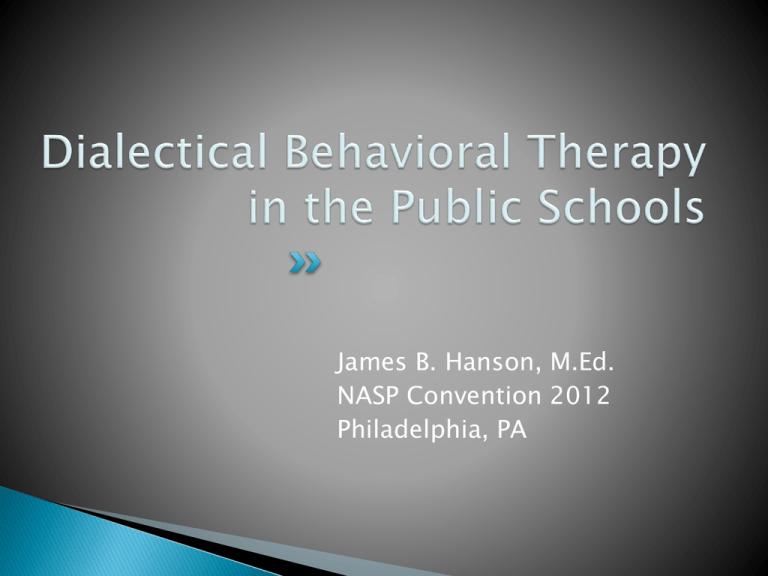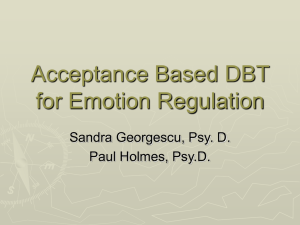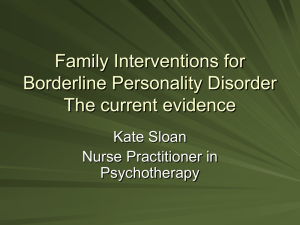PowerPoint presen - National Association of School Psychologists
advertisement

James B. Hanson, M.Ed. NASP Convention 2012 Philadelphia, PA What is DBT? Core Components Adaptation to School Settings Why Did Lincoln High School Choose DBT? How was DBT implemented? Research Results Supports and Challenges to School Implementation A synthesis of: Behaviorism Mindfulness Dialectics Dialectics: “A means of finding fluidity and balancing acceptance and change in the fact of rigidity and impasse” (Miller et. al 2007). There is no absolute truth; everyone has something to offer. I am doing the best I can and I can do better. I am tough and I am gentle. I may not have caused all of my problems, but I’m responsible for working on them. A life worth living has happiness, sadness, anger, and calm, and all of these things are valuable and necessary. Acceptance Mindfulness Radical Acceptance Validation Change Problem Solving Cognitive Behavioral Goals and Contingencies Marsha Linehan, University of Washington Attempts at traditional Cognitive Behavioral Therapy with suicidal and self-injurious clients did not work Dialectical Behavioral Therapy with Suicidal Adolescents (2007). Alec Miller, Jill Rathaus, Marsha Linehan. New York: The Guilford Press Multi-diagnosed BPD (Borderline Personality Disorder) PTSD Para-suicidal Behavior in Teens (cutting) Eating Disorders (bulimia and binge eating) Antisocial Personality Depression in Elderly, Emergent in Teens Emotional Regulation (labile, anger) Interpersonal Regulation (chaotic, abandoned) Self Regulation (identity, emptiness) Behavioral Regulation (suicide, cutting, impulsive) Cognitive Regulation (black and white thinking) Individual Emotional Regulation Problems Biological, Genes, Emotional Vulnerabilities Invalidating Environment (e.g., Chronic stress, chaos, perfectionism, inconsistency) Learning: Observational, Operant, Respondent Mindfulness Interpersonal Effectiveness Emotional Regulation Problem Solving (CBT, FBA) Distress Tolerance Creating a Life Worth Living Increasing Behavioral Skills Decreasing Quality-of-Life Interfering Behavior Decreasing Therapy-Interfering Behavior Decreasing Life Threatening Behaviors Reciprocal Responsive Serious Appropriate SelfDisclosure Warm Engagement Radical Genuineness Irreverent Unorthodox Reframing Plunging In-Humor Confrontation Calling The Bluff Omnipotence and Impotence Intensity and Silence Dialectical Behavioral Therapy with Suicidal Adolescents (2007) 12-16 week treatments instead of 1 year Suicidal ideation, depression, and anxiety (perfectionism) Six problem areas (violence, drinking, drugs, smoking, risky sexual behavior, disturbed eating) Rathaus & Miller (2002)-Adolescents ◦ Lower hospitalization (TAU 13% versus DBT 0%) ◦ Higher retention (TAU 40% versus DBT 62%) Fellows (1998)-Adolescents ◦ Treatment group went from 539 inpatient hospital days pretreatment to 51 days post treatment Target population – same as research? Comprehensive DBT – all components? Setting – amenable finances, time, structure? Professional training – skill set, credentials? “Gold Standard” Five functions – skills, generalization, and environment of clients; capabilities and motivation of therapists 1400 students Middle to high socio-economic status 100 Best High Schools in United States Suicide was leading cause of death About 20 parent meetings/year for cutting, suicidal ideation or attempt High stress and anxiety (OHTS 2008: 13% of students considered suicide in last twelve months; 2012: 8.4%) Before DBT: one to two suicides per year, since DBT no suicides Before DBT: two to three placements into Portland Public School’s day treatment classroom per year, since DBT one placement CDC Coordinated School Health Model PBIS RESPONSE suicide prevention Student & Staff Anti-Bullying Reconnecting Youth School Improvement Plan with Mental Health goals 19 20 Character Traits: Respect, Understanding, Integrity, Community, Purpose Explain how to build and maintain healthy relationships Classify personal stressors at home, in school, peers Describe how social environments affect well-being Identify resources at home, school, and in the community for managing family and relationship problems Practice strategies for managing and reducing stress, anger and conflict Demonstrate the ability to take the perspective of others in a conflict situation Identify influences that contribute to positive and negative self-image Demonstrate pro-social communication skills Demonstrate the steps in problem solving, anger management and impulse control . STUDENT ACHIEVEMENT GOAL (SMART GOAL): 1.Students will increase healthy habits and reduce alcohol, tobacco and drug use. 2.Students will increase knowledge of human diversity and develop interpersonal skills to counter bullying, harassment and conflict. 3.Students will develop mindfulness, distress tolerance, and emotional regulation skills, recognize the signs of anxiety/depression/suicide, and access appropriate support services when needed. 24 Weekly Skills Class with two co-facilitators Weekly Individual Sessions “Phone Calls” (consultation to student in the counseling center for emergencies during the day when coaching on skills and reassurance is needed) Parent training Weekly DBT providers team meeting “Advanced Health” on transcript; DBT is an elective credit class Materials from Portland DBT Teen Program Lincoln Staff/Teacher Training Consultation with community providers Fidelity checks from Portland DBT Program Possible inclusion of DBT curriculum for general education health classes: University of Washington, James Mazza developed curriculum Self-referral from one-day preview of DBT skills in general education health classes PBIS: Students who did not do well enough in Reconnecting Youth or mentoring program IEP: Students identified with social/emotional needs Students in day treatment who have collaborative problem solving skill base Tier classification depends on student “I am familiar with the assumptions and theory of DBT” “I agree to participate in DB Skills Training Class and individual coaching” Parents agree to monthly parent meeting BASC-2 teacher, parent, & self: pre and post Diary card: basis of individual coaching FBA as part of the coaching: Target Behavior If suicidal, not the only counseling service If cutting or eating disorder is serious, referral to Portland DBT or other communitybased therapy Step down or “graduates” from LHS DBT, other programs, community DBT, and PPS day treatment as appropriate No requirement to quit other therapy: consultation with community provider Identifiable “target behavior” Student will use social/emotional and behavioral skills to improve her scores on measures of Sense of Inadequacy, Anxiety, Depression, Atypicality and Withdrawal BASC2 scales from the clinically significant to the average range on parent, teacher, and selfreport Student will demonstrate the steps in problem solving, anger management, and impulse control by completing readings, discussion, and 100% of homework, including functional behavioral analysis, on problemsolving and emotional regulation skills. Evaluation Procedures: transcript for GPA, school attendance, Advanced Health class attendance/homework, diary card, FBA, BASC-2. Mindfulness Interpersonal Effectiveness Emotional Regulation Problem Solving (CBT, FBA) Distress Tolerance Mindfulness exercise Homework New Skill Discussion and examples FBA if emerging pattern of not doing homework, coming late, or other therapyinterfering behavior Black and white? Seeing polarities “Both/and” not “either/or” A life worth living has positive and negative aspects Getting unstuck Full awareness Present Moment Wise Mind (Emotional & Logical) Observe, Describe, Participate, Don’t Judge, Focus, Do What Works Half Smile Goal Setting Chain Analysis (Functional Behavioral Analysis) Stinking Thinking Pain is a part of life Pain versus suffering Some things you can’t change If you act impulsively, you can hurt yourself, others, and your goals Act Contribute Compare Emotional Opposite Push Away (Bracket) Thought Change Sensation Change Self-Soothe Kits Vision Hearing Taste Smell Touch Movement FEAR-HideApproach ANGER-AttackGently Avoid SAD-Withdraw-Get Active GUILT-Avoid-Face Radical Acceptance Acknowledge, Recognize, Endure Myths: It’ll Change, It’ll Kill Me, It’ll Last Forever RIDING THE WAVE You are not the wave Don’t avoid it Don’t judge it Don’t make it bigger or smaller Don’t hold on to it What’s Your Objective?-DIG Relationship-GIVE Your Goals-RAN Self Respect-FAST Share more deeply than in the class Class does not allow sharing of examples that have to do with cutting, suicidal ideation, or other matters that might trigger other students Diary card guides the session If diary card isn’t done, then student must complete then and there, and have less time to talk to coach Every student has the chance to receive immediate consultation during the week if trying to use skills and they aren’t working Accommodation in IEP or 504 to come to the counseling center to see their DBT coach Communicated to teachers if not on IEP/504 See the student before target behavior occurs Do not see the student for 24 or 48 hours after target behavior occurs Shaping appropriate help-seeking Purpose: “To allow therapists to discuss their difficulties providing treatment in a nonjudgmental and supportive environment that helps improve their motivation and capabilities” (Miller, et. al., 2007). “Group therapy for therapists” Integral part of DBT program Who has been a member of Lincoln’s DBT Team: School Psychologist, School Nurse, School Social Work Intern, School Psychology Practicum Student, School Counselor, School Counseling Intern Core Team Training: 6 Days, Portland DBT Readings: Miller (2007) Linehan (1993) Leader Training for School Psychologist: 6 Days, Portland DBT 6 Days per year, Behavioral Tech Five cohorts: 2009 2010 2010 2011 2012 Girl’s Group, Closed, Semester Mixed Group, Closed, Semester Mixed Group, Open, Year-Long Mixed Group, Closed, Year-Long Mixed Group, Closed, Semester BASC-2 Pre and Post (Student, Parent, Teacher Versions) Attendance Grade Point Average Written Reflection Progress Monitoring: Daily Diary Cards BASC-2 Scores – Decreases in Anxiety (8), Depression (12) and Social Stress (7) Attendance - Increases up to 30% Grade Point Average – from no increase to 1.43, Average .80 “This group rocked. I learned a lot and you were pretty tough on me. You know that, right?” “All those chain analyses. They laid it all right out, like, ‘Girl, this is your life.’ It helped me quit smoking and I’m not cutting on myself anymore.” “Now I like myself. After group ended, a relationship failed. I did ‘accepting myself rehab’ and it worked.” “This is kind of messed up, but how the other girls handled their problems reminded me that I was actually better at using the skills than many of them were. That’s a ‘comparison’ skill.” Slight increases in attendance and bigger increases in GPA Modest decreases in Anger Control, Anxiety All but one student on IEP or Safety Plan for suicide attempt/serious suicidal ideation BASC-2 ESI < 10, Internalizing < 4, Depression < 9, Anxiety < 4 Grade Point Average +.10 (2/8 Students -.8, most other students gained about +.4) Attendance dropped by 10 days per year “The Mindfulness skill allowed me to heighten my awareness of my limits. I’m more aware of when I’m overworked, or over emotional and I know what triggers the overload.” “My experience here with DBT has been truly life changing. I’ve developed skills that will help me the rest of my life.” Average increase in GPA = + .76 11 of 12 students increased GPA Average increase in attendance = + 4% Attendance not interpretable, 5/12 students decreased attendance slightly, 1 student significantly increased BASC-2 Self Report t-scores Anxiety: average decrease 13.9 (-35 to +6) Depression: average decrease 18.7 (-40 to 4) Internalizing: average decrease 15.2 (-37 to +4) ESI: average decrease 16.0 (-33 [2] to +2) ADHD not medicated Depersonalization Disorder Students with parent who did not attend parent classes Narcissistic traits: difficulty with group format What’s up with lower attendance rates and higher GPA’s? Syllabus Administrative and parent buy-in Tier Two and Tier Three School Improvement Plan Health Action Network Funds District support No suicides since REPONSE, RY, and DBT One placement in more restrictive setting Savings to district: $350,000 Day treatment classroom at Lincoln with Collaborative Problem Solving model: teaching to other teachers Time constraints for class New block schedule lessens flexibility Scheduling individual appointments for students not in SPED Time intensity for program Training new staff every year Parent group: have had to modify format Changing special education administration Perception of “therapy” versus “counseling” Research parameters But It Ain’t Bad Jim Hanson, M.Ed. JaBrHanson@yahoo.com (503) 916-6087











